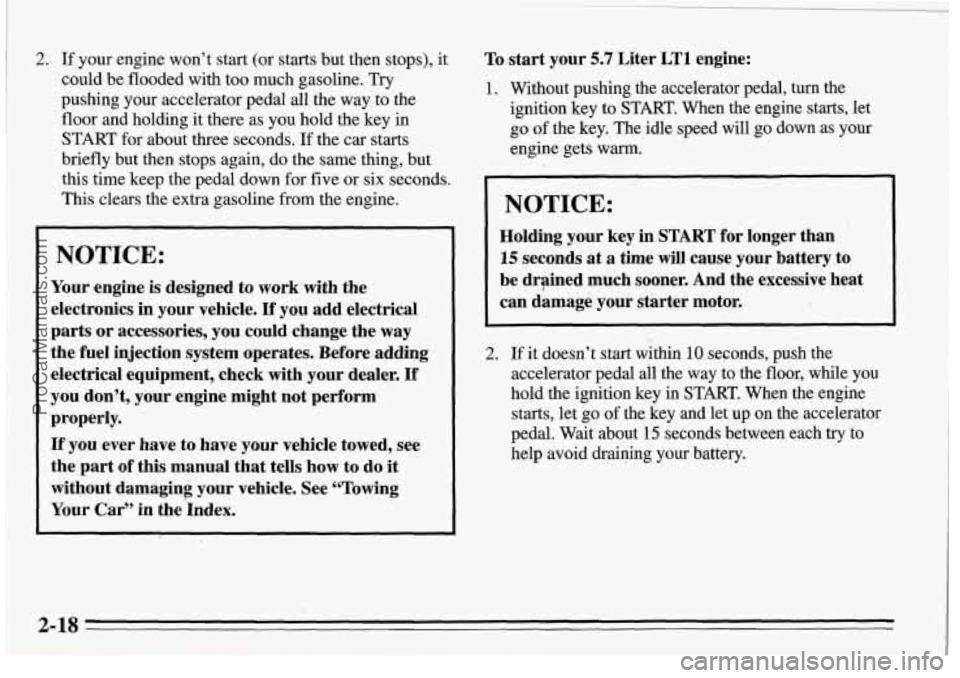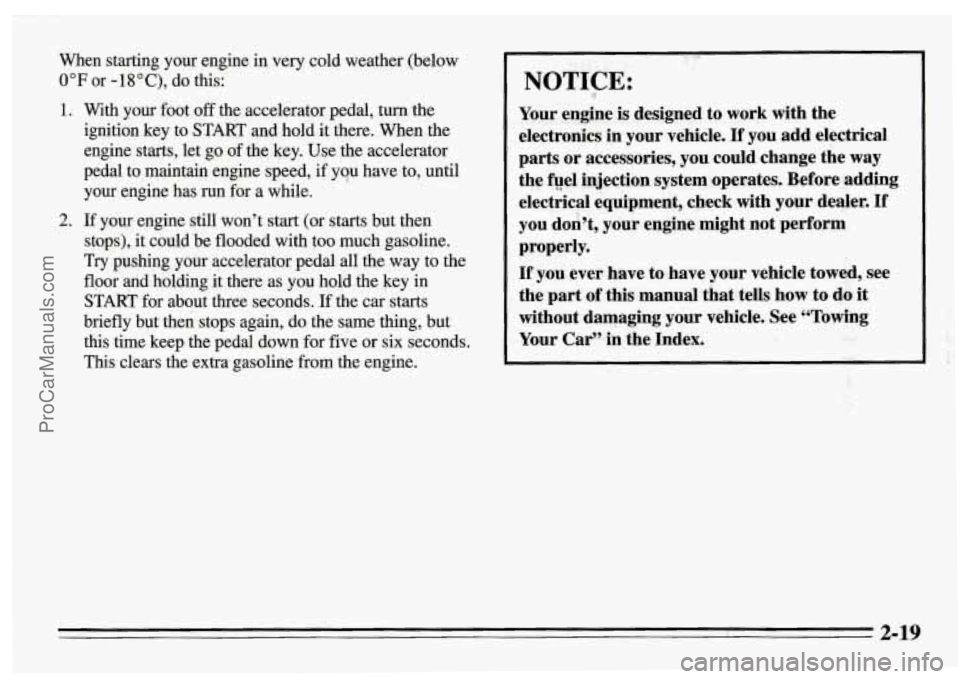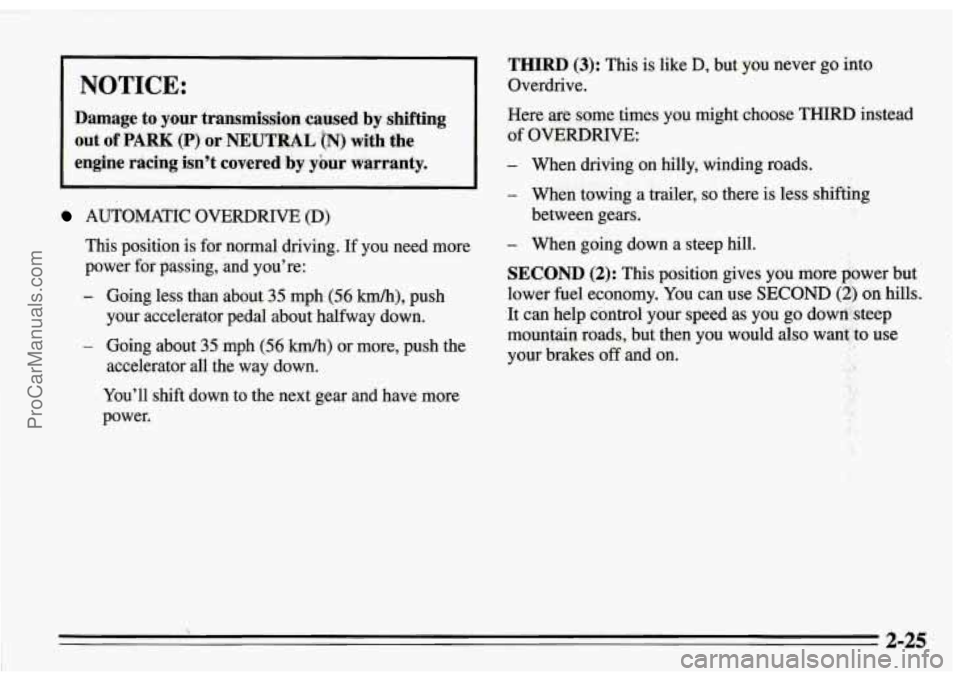tow PONTIAC FIREBIRD 1995 Owners Manual
[x] Cancel search | Manufacturer: PONTIAC, Model Year: 1995, Model line: FIREBIRD, Model: PONTIAC FIREBIRD 1995Pages: 386, PDF Size: 19.66 MB
Page 13 of 386

Head Restraints
Slide the head restraints up or down so that the top of
the restraint is closest to the top of your ears.
This position reduces the chance of a neck injury in a
crash.
If you have the fully articulating sport seat, you have a
six-way head restraint. It can be adjusted up and down,
forward and rearward, or tilted.
To adjust it forward, pull the restraint forward. To adjust
it reward, pull the restraint forward
all the way to
release it. Then move it to the position you want.
Front Seatback Latches
The front seatback folds forward to let people get into
the back seat.
To fold a seatback forward, push the
seatback toward.the rear as you lift this latch. Then the
seatback
will fold forward.
When you return the seatback to its original position,
make sure the seatback is locked. The latch must be
down for the seat to work properly.
ProCarManuals.com
Page 30 of 386

impacts, or rear impacts, because inflation would not
help the occupant.
It is possible that in a crash only one of the two air ,bags
in your Pontiac will deploy. This ishare, but
can happen
in a crash just severe enough to make an air bag inflate.
,, _.. . .> . .~
In any particular crash, no one can say whether an air
bag should have inflated simply because of the damage
to a vehicle or because
of what the repair costs were.
Inflation is determined by the angle of the impact and
the vehicle’s deceleration. Vehicle damage is only one
indication of this.
What makes an air bag inflate?
In a frontal or near-frontal impact of sufficient severity,
the air bag sensing system detects that the vehicle is
suddenly stopping as a result
of a crash. The sensing
system triggers a chemical reaction of the sodium azide
sealed in the inflator. The reaction produces nitrogen
gas, which inflates the air bag. The inflator, air bag, and
related hardware are all part of the air bag modules
packed inside the steering wheel and in the instrument
panel in front of the right front passenger.
How does an air bag restrain?
In moderate to severe frontal or near-frontal collisions,
,‘.\.,, evep . belted occqymts can contact the steering wheel or
the instrument panel. The air bag supplements the
protection provided by safety belts.
Air bags distribute
the force of the impact more evenly over the occupant’s
upper body, stopping the occupant more gradhdly. But
air bags would not help you in many types
of kollisions,
including rollovers and rear and side impacts, primarily
because an occupant’s motion is not toward the air bag.
Air bags should never be regarded as anythingmore
than a supplement to safety belts, and then
od$ in
moderate to severe frontal or near-frontal colliiions.
What will you see after an air bag inflates?:.: 1 i
After the air bag inflates, it quickly deflates. &is occurs
so quickly that some people may not even realize the air
bag inflated. Some components
of the air bag module in
the steering wheel hub for the driver’s air bag, or the
instrument panel for the right front passenger’s bag, will
be hot for a short time, but the part
of the bag that comes
into contact with you will not be hot to the touch. There
will be some smoke and dust corning from vents in the
deflated air bags. Air bag inflation will not prevent the
driver from seeing
or from being able to steer the
vehicle, nor will it stop people from leaving the vehicle.
i
1-23
ProCarManuals.com
Page 45 of 386

Accident statistics show that children are safer if they
are restrained in the rear seat. But they need to use the
safety belts properly.
Children who aren’t buckled up can be thrown out in
a crash.
a Children who aren’t buckled up can strike other
people who are.
@ What if a child is wearing a lap-shoulder belt,
but the child is so small that the shoulder belt is
very close to the child’s face or neck?
A: Move the child toward the center of the vehicle, but
be sure that the shoulder belt still is on the child’s
shoulder,
so that in a crash the child’s upper body
would have the restraint that belts provide.
ProCarManuals.com
Page 61 of 386

New Vehicle “Break-In” Ignition Switch
NOTICE:
Your modern Pontiac doesn’t need an elaborate
%break-in.” But it
will perform better in the long
run
if you follow these guidelines:
0
0
0
0
Keep your speed at 55 mph (88 km@) or
less for the first
500 miles (804 km).
Don’t drive at any one speed
-- fast or slow
-- for the first 500 miles (804 km). Don’t
make full-throttle starts.
Ayoid making hard stops for the first
2a0: miles (322 kni) or so. During this time
your new brake linings aren’t yet broken
in. Hard stops with new linings can mean
premature wear and earlier replacement.
Follow this “breaking-in” guideline every
time you get new brake linings.
Don’t tow a trailer during “break-in.” See
“Towing a Trailer” in the Index for more
information.
With the ignition key in the ignition switch, you can turn
the switch to five positions:
ACC (A): Position in which you can operate your
electrical power accessories. Press in the ignition switch as you
turn the top of it toward you.
LOCK (B): The only position in which you can remove
the key. This locks your steering wheel, ignition and
automatic transmission.
2-14
ProCarManuals.com
Page 62 of 386

If you have an automatic transmission, the ignition
switch can’t be turned to
LOCK unless the shift lever is
in the PARK (P) position.
OFF (C): Unlocks the steering wheel, ignition and
automatic transmission, but does not send electrical
power to
any accessories. Use this position if your
vehicle must be pushed or towed.
A warning tone will
sound if you open the driver’s door when the ignition is
OFF and the key is in the ignition.
RUN (D): Position to which the switch returns after you
start your engine and release the switch. The switch
stays in the
RUN position when the engine is running.
But even when the engine is not running, you can use
RUN to operate your electrical power accessories and to
display some instrument panel warning and indicator
lights.
START (E): Starts the engine. When the engine starts,
release the key. The ignition switch will return to
RUN
for normal driving.
Note that even if the engine is not running, ACC and
RUN allow you to operate your electrical accessories,
such as the radio and ventilation fan.
Key Release Button: If you have a manual
transmission, your ignition lock has
a key release button.
You must press the button before you can take: your key
out
of the ignition lock.
2-15
ProCarManuals.com
Page 65 of 386

2. If your engine won’t start (or starts but then stops), it
could be flooded with too much gasoline. Try
pushing your accelerator pedal all the way to the
floor and holding it there as you hold the key in
START for about three seconds. If the car starts
briefly but then stops again, do the same thing, but
this time keep the pedal down for five or six seconds.
This clears the extra gasoline from the engine. ~ ~
NOTICE:
Your engine is designed
to work with the
electronics in your vehicle.
If you add electrical
parts or accessories9 you could change the
way
the fuel in&tion system operates. Before adding
electrical equipment, check with your dealer.
If
you don’t, your engine might not perform
properly.
If you ever have to have your vehicle towed, see
the part
of this manual that tells how to do it
without damaging your vehicle. See “Towing
Your Car” in the ‘Index.
To start your 5.7 Liter LT1 engine:
1. Without pushing the accelerator pedal, turn the
ignition key to START. When the engine starts, let
go
of the key. The idle speed will go down as your
engine gets
warm.
I
NOTICE:
Holding your key in START for longer than
15 seconds at a time will cause your battery to
be drained much sooner. And the excessive heat
can damage your starter motor.
2. If it doesn’t start within 10 seconds, push the
accelerator pedal all the way to the floor, while you
hold the ignition key in START. When the engine
starts, let go
of the key and let up on the accelerator
pedal. Wait about
15 seconds between each try to
help avoid draining your battery.
2-18
ProCarManuals.com
Page 66 of 386

When starting your engine in very cold weather (below
0°F or -18"C), do this:
1. With your foot off the accelerator pedal, turn the
ignition key to START and hold it there. When the
engine starts, let
go of the key. Use the accelerator
pedal to maintaiq engine speed, if you have to, until
your engine has run for
a while.
stops), it could be flooded with too much gasoline.
Try pushing your accelerator pedal all the way to the
floor and holding it there as you hold the key in
START for about three seconds. If the
car starts
briefly but then stops again,
do the same thing, but
this time keep the pedal down for five or six seconds.
This clears the extra gasoline from the engine.
2. If your engine still won't start (or starts but then
' NOTICE:
- Ir
7
Your engine is designed to work with the
electronics in your vehicle.
If you add electrical
parts or accessories, you could change the
way
the fuel injection system operates. Before adding
electrical equipment, check with your dealer.
If
you don't, your engine might not perform
properly.
If you ever have to have your vehicle towed, see
the part of this manual that tells how to do
it
without damaging your vehicle. See "Towing
Your Car" in the Index.
' 4+
2-19
ProCarManuals.com
Page 71 of 386

Ensure the shift lever is fully in PARK (P) range
before starting the engine. Your Pontiac has a
brake-transmission shift interlock. You have to fully
apply your regular brakes before you can shift from
PARK (P) when the ignition key is in the RUN position.
If you cannot shift out of PARK (P), ease pressure on
the shift lever
-- push the shift lever all the way into
PARK
(P) and also release the shift lever button on floor
shift console models
as you maintain brake application.
Then move the shift lever into the gear you wish. (Press
the shift lever button before moving the shift lever on
floor shift console models.) See “Shifting Out of
PARK (P) in
this part.
REVERSE (R): Use this gear to back up.
NOTICE:
Shifting to REVERSE (R) while your vehicle is
moving forward could damage your transmission. Shift to REVERSE
(R) only after
your vehicle is stopped.
To rock your vehicle back and forth to get out of snow,
ice or sand without damaging your transmission, see
“Stuck:
In Sand, Mud, Ice or Snow, If You’re” in the
Index.
NEUTRAL (N): In this position, your engine doesn’t
connect with the wheels.
To restart when you’re
already moving, use NEUTRAL
(N) only. Also, use
NEUTRAL,
(N) when your vehicle is being towed.
ProCarManuals.com
Page 72 of 386

NOTICE:
THIRD (3): This is like D, but you never go into
Overdrive.
Damage to your transmission caused by shifting Here are some times you might choose THIRD instead
out of PARK (P) or NEUTRAL [N) with the of OVERDRIVE:
engine racing isn’t covered by your warranty. - When driving on hilly, winding roads.
- When towing a trailer, so there is less shifting
AUTOMATIC OVERDWE (D) between gears.
This position is for normal driving. If you need more
power for passing,
and you’re:
- Going less than about 35 mph (56 kmk), push
your accelerator pedal about halfway down.
- Going about 35 mph (56 kmk) or more, push the
accelerator all the way down.
You’ll shift down to the next gear and have more
power.
- When going down a steep hill.
SECOND (2): This position gives you more power but
lower fuel economy.
You can use SECOND (2) on hills.
It can help control your speed as you go dowri-:.steep
mountain roads, but then you would also want-to use
’,
your brakes off and on.
4
!
1
I
ProCarManuals.com
Page 80 of 386

If you are towing a trailer and are parking on any
hill: See“Towing a Trailer” in the Index. That section
shows what to
do first to keep the trailer from moving.
To release the parking brake:
L
Hold the brake pedal down. Pull the parking brake lever
up until you
can push in the release button. Hold the
release button in as you move the brake lever all the way
down.
NOTICE:
Driving with the parking brake on can cause
your rear brakes to overheat.
You may have to
replace them,
and you could also damage other
parts
of your vehicle.
2-33
ProCarManuals.com